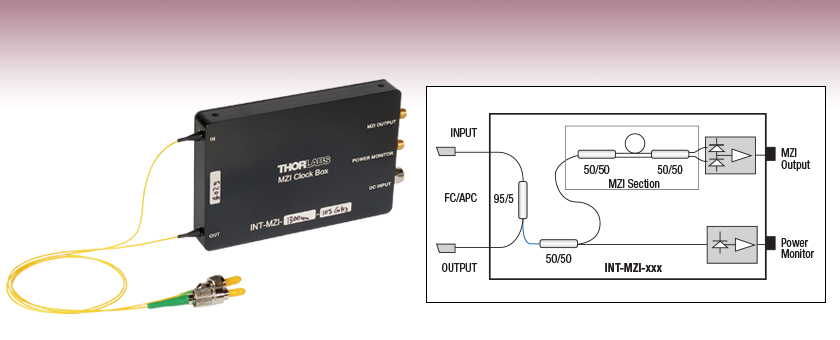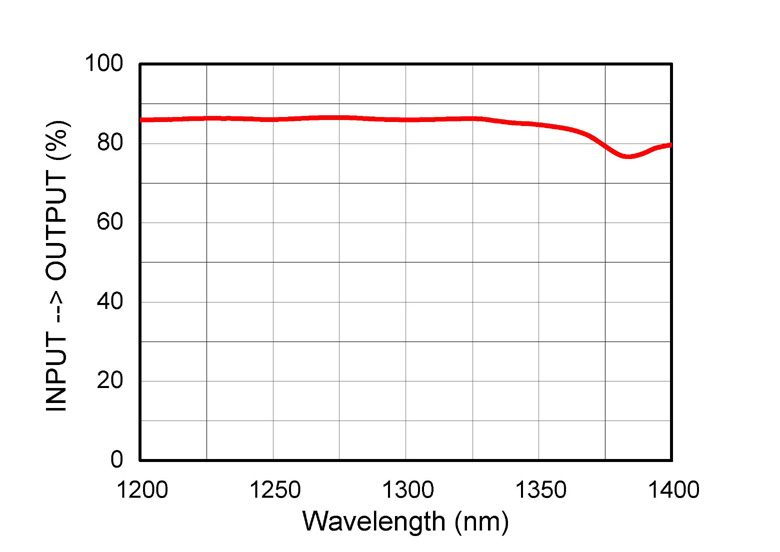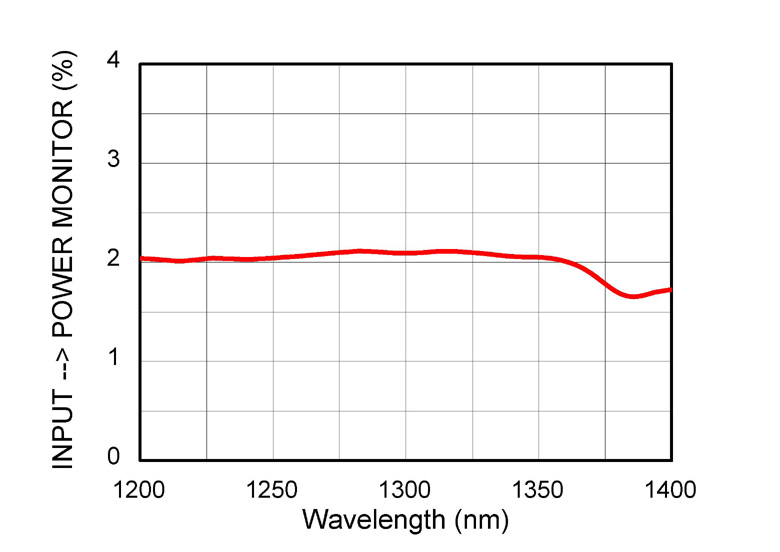Mach-Zehnder Type Interferometer

- OCT-Proven Clock for Swept Source Systems
- Compact Design that Allows Subassembly Integration
- Several Wavelengths Available
INT-MZI-1300

Please Wait
| Item # | Wavelength Rangea |
Detector Type |
Free Spectral Range |
Insertion Lossa |
|---|---|---|---|---|
| INT-MZI-850 | 780 - 925 nm | Si/PIN | 103.3 GHz ± 5% | <1.5 dB (Typ.), 3 dB (Max) |
| INT-MZI-1300 | 1225 - 1375 nm | InGaAs/PIN | <0.7 dB (Typ.), 1 dB (Max) |
Features
- For 850 nm or 1300 nm Center Wavelengths
- Ideal for Swept Source Output Frequency Monitoring
- Balanced Detection Output
- Low Insertion Loss: <3 dB
- Flat Wavelength Response
- Integrated Signal Detection for Power Monitor and k-Clock Signals
- Interferometer Power Supply Included
Thorlabs' Mach-Zehnder interferometer clock box subassemblies are designed to be used inside a swept source OCT system with a central wavelength of either 850 nm or 1300 nm. The internal fiber couplers are optimized for flat wavelength responses and coupling losses that have a very low polarization dependence, which make the output signals independent of input polarization changes. The clock box contains two detectors, providing a power monitor signal and a k-clock signal that monitors the output frequency of the swept source. Both outputs have a 200 MHz bandwidth, and the k-clock uses a balanced detection scheme to maximize rejection of common mode noise.
Although originally designed for OCT systems, this clock can also be used for other synchronization applications.
For more details on the clock, please see the Operating Principles Tab.
Note: Custom models are available with a choice of free spectral range and wavelength. Please contact Tech Support for more information.
| Item # | INT-MZI-850 | INT-MZI-1300 |
|---|---|---|
| Optical Specifications | ||
| Interferometer Wavelength Range | 780 - 925 nm | 1225 - 1375 nm |
| Free Spectral Range | 103.3 GHz ±5% | 103.3 GHz ±5% |
| Fiber Type | Nufern 780-HP™ | Corning SMF28™ |
| Input/Output Connection | FC/APC Pigtail, 50 cm Long | |
| Insertion Lossa | <1.5 dB (Typ.), 3 dB (Max) | <0.7 dB (Typ.), 1 dB (Max) |
| Electrical Specifications | ||
| Detector Material/Type | Si/PIN | InGaAs/PIN |
| Detector Wavelength Range | 320 - 1000 nm | 800 - 1700 nm |
| Typical Responsivity (Max) | 0.53 A/W | 1.0 A/W |
| MZI Output Bandwidth (3dB) | DC - 200 MHz | |
| Conversion Gain Power Monitorb | 30 V/W (±25%) | 60 V/W (±25%) |
| Conversion Gain MZI Outputb | ±30 V/W (±25%) | ±60 V/W (±25%) |
| Saturation Power | 100 mW @ 850 nm | 50 mW @ 1300 nm |
| Maximum Input Power | 250 mW (Photodiode Damage Threshold) | |
| Electrical Outputs | SMA | |
| Impedance | 50 Ω | |
| DC Offset | < ±5 mV | |
| Power Supply | ±12 V @ 250 mA (100/120/230 VAC, 50 - 60 Hz, Switchable) |
|
| General Specifications | ||
| Dimensions | 120 mm x 80 mm x 16 mm | |
Operating Principles
Rapidly swept laser sources typically use sinusoidal tuning elements to achieve the very fast optical frequency sweep speeds required for OCT imaging applications. Hence, accurate and reliable re-calibration of the OCT signal is required so that the final data points are equidistant in frequency. The Thorlabs swept source laser features a built-in Mach-Zehnder Interferometer (MZI) with balanced detector output that can be used for just this purpose. A frequency clock is derived from the zero crossings of the MZI interference fringe signal; these zero crossings are equally spaced in optical frequency (k-space). While this clock is intended for OCT applications, it can also be used in other synchronization applications.

Figure 1: MZI Clock Signal
The schematic of the system is shown in figure 2 below. An internally fiber network is used to tap 5% of the input light to generate Power Monitor and k-clock signals. The remaining light is transmitted to the Output pigtail. Specially designed couplers are used to achieve a flat wavelength response for both the transmitted and the Power Monitor signal. (see figures 3 and 4 below). Both signals of the MZI are detected by an ultra-low noise amplified balanced photo detector.

Figure 2: Schematic of MZI Series Clock Box

Figure 3: Coupling Ratio for INT-MZI-1300 from Input to Output

Figure 4: Coupling Ratio for INT-MZI-1300 from Input to Power Monitor
Power Monitor Output
SMA Female

0 - 1.8 V (50 Ω) or 0 - 3.6 V (High Z)
Mach-Zehnder Interferometer Output
SMA Female

0 - 1.8 V (50 Ω) or 0 - 3.6 V (High Z)
| Posted Comments: | |
Nico Neumann
(posted 2022-11-02 15:42:35.777) Can you specify the robustness of the FSR to temperature changes? How temperature stable are your MZI? dpossin
(posted 2022-11-04 12:42:10.0) Dear Nico,
Thank you for your feedback. As we do not specify the MZI outside of the temperature range of 23°C +/- 5°C we currently can´t make a statement on the actual robustness. Since the fibernetwork inside the case will increase or decrease in length as the temperature changes potentially the frequency mismatch will increase too. I´ll reach out to you in order to further discuss this issue. ming-wei lai
(posted 2021-07-25 20:00:40.143) I set up a SSOCT system. Our DAQ is NI usb-6356, sample rate is 1MSPS(mega sample per second) , Laser is TLS-550 center wavelength is 1310nm.
I wanna know your product's limit. Can I using this in our system? MKiess
(posted 2021-08-05 03:43:39.0) Dear Ling-Wei Lai, thank you for your inquiry. I have contacted you directly to discuss the exact application and requirements for implementing the interferometer in your system. ckdgus6819
(posted 2017-03-28 12:45:01.22) Do you have 1500nm MZI clock box?? swick
(posted 2017-03-30 03:21:23.0) This is a response from Sebastian at Thorlabs. Thank you for the inquiry.
We can offer customized version of our Mach-Zehnder Type Interferometers for different wavelengths. I will contact you directly to check your requirements in detail. amahend
(posted 2016-05-25 10:56:25.543) Do you have similar product mach zehnder interferometer but the MZI output using optical connector (or remove the PD) so this can act as delay line interferometer? besembeson
(posted 2016-05-25 05:22:21.0) Response from Bweh at Thorlabs USA: We don't have such a fiber based interferometer at this time. We could look into a custom solution according to your requirements. I will contact you. jlow
(posted 2012-11-01 13:17:00.0) Response from Jeremy at Thorlabs: The MZI clock isn't designed for external clocking the DAQ card. Instead the MZI clock signals are acquired by the DAQ card simultaneously with the OCT signals. Then software is used to process the MZI clock signals and interpolate the zero-crossing to build the time-to-frequency conversion to perform a linear FFT. The number of raw clock points that comes out of the MZI is about 400-450 points. We recommend interpolating approximately 4x those points to perform a 2048 point FFT. avle
(posted 2012-10-24 02:06:41.657) How many points per scan does the mzi clock generate when using the SL1325-P16 laser for external clocking? Tyler
(posted 2008-03-18 10:51:24.0) Response from Tyler at Thorlabs to r93941013: Thank you for your interest in our product. The output of the MZI Clock Box can be used to trigger the data acquisition board. The output signal consists of a sinusoidal signal with zero crossings that are equally spaced in frequency. r93941013
(posted 2008-03-16 21:49:52.0) Hello,
I am interested in this product. About the clock box, the MZI output signal could be directly used as the clock signal of data acquistion board? If not, the advanced calculation inplementation is required. Therefore, more input channel is essential fro frequency calibration. Waiting for more deailed response, thx. By the way, our primary application is swept source OCT application.
Hsiang Chieh Lee
National Taiwan University, Taiwan |
 Products Home
Products Home







 Mach-Zehnder Interferometer Clock Box
Mach-Zehnder Interferometer Clock Box